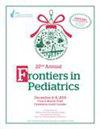小儿肾炎中 CVID 和肉样瘤病重叠的病例报告
IF 2.1
3区 医学
Q2 PEDIATRICS
引用次数: 0
摘要
常见变异性免疫缺陷病(CVID)可并发肉芽肿性疾病,通常是肉芽肿性淋巴细胞间质性肺病(GLILD)。肉芽肿性间质性肾炎是儿科的一种非典型表现。我们的患者是一名 13 岁的白人男性,以前身体健康,最近被诊断为 CVID。他出现皮疹,实验室检查结果包括全血细胞减少(白细胞 2.6 × 103/μl,血红蛋白 11.8 g/dl,血小板 60 × 103/μl)、高钙血症(14.9 mg/dl)、维生素 D 1,25 OH 水平升高(>200 pg/ml)、高尿酸血症(8.8 mg/dl)和急性肾损伤(AKI)(血清肌酐 1.1 mg/dl;基线 0.64 mg/dl)。广泛的感染性检查没有发现异常。使用多西环素后,皮疹有所好转。通过液体复苏、降钙素和唑来膦酸治疗了高钙血症和高尿酸血症。包括正电子发射断层扫描在内的恶性肿瘤评估发现了多个纵隔高代谢淋巴结和肺磨玻璃不透明,后来通过计算机断层扫描(CT)报告为肺部小结节。超声波和计算机断层扫描证实了脾肿大。外周涂片、骨髓活检和基因检测均未发现异常。他的血管紧张素转换酶水平升高(359 U/L),令人担心他患了肉样瘤病。考虑到他已处于 AKI 阶段,医生对他进行了肾活检,结果发现他患有非酪氨酸肉芽肿性间质性肾炎。由于推测为肉样瘤病,他开始接受60毫克泼尼松治疗,为期4个月,结果导致类固醇引起的高血压和情绪变化。唑来膦酸对血清肌酐的降低作用微乎其微。由于 T 细胞全血细胞减少,患者开始接受肺孢子虫肺炎预防治疗。胸部 CT 结果显示,患者对类固醇的反应不佳。支气管肺泡灌洗显示有 50%的淋巴细胞(正常值为 10%),肺活检显示有非酪氨酸肉芽肿,表明患的是 GLILD。经染色鉴定为风疹。发烧后,他被发现肝酶升高,CT 证实患有门静脉高压性肝炎。肝活检发现上皮样非酪化肉芽肿,PCR检测出HHV6。他因持续中性粒细胞减少症接受了四个周期的利妥昔单抗和粒细胞集落刺激因子治疗。随后使用霉酚酸盐治疗后,肉芽肿病变和细胞减少症得以缓解。CVID罕见的并发症--肉芽肿性间质性肾炎说明了诊断的复杂性。该病例强调,必须全面了解患者的临床和免疫表型,包括独特的放射学表现,才能对 CVID 进行精确诊断和有针对性的治疗。本文章由计算机程序翻译,如有差异,请以英文原文为准。
A case report navigating CVID and sarcoidosis overlaps in pediatric nephritis
Common variable immunodeficiency (CVID) can be complicated by granulomatous disease, often granulomatous lymphocytic interstitial lung disease (GLILD). Granulomatous interstitial nephritis represents an atypical presentation in pediatrics. Our patient is a previously healthy 13-year-old white male with a recent diagnosis of CVID. He presented with a rash and laboratory findings included pancytopenia (white blood cells 2.6 cells × 103 /μl, hemoglobin 11.8 g/dl, platelets 60 × 103 /μl), hypercalcemia (14.9 mg/dl), elevated Vit D 1,25 OH level (>200 pg/ml), hyperuricemia (8.8 mg/dl), and acute kidney injury (AKI) (serum creatinine 1.1 mg/dl; baseline 0.64 mg/dl). A broad infectious workup was unremarkable. The rash improved with empiric doxycycline. Hypercalcemia and hyperuricemia were managed with fluid resuscitation, calcitonin, and zoledronic acid. Evaluation for malignancy including a positron emission tomography scan, revealed multiple mediastinal hypermetabolic lymph nodes and pulmonary ground glass opacities, later reported as small pulmonary nodules by computed tomography (CT). Splenomegaly was confirmed by ultrasound and CT. Peripheral smear, bone marrow biopsy, and genetic testing were non-revealing. His angiotensin-converting enzyme level was elevated (359 U/L), raising concerns for sarcoidosis. Given Stage 1 AKI, a renal biopsy was pursued and identified non-caseating granulomatous interstitial nephritis. Treatment with 60 mg of prednisone began for presumed sarcoidosis for 4 months, causing steroid-induced hypertension and mood changes. Zoledronic acid minimally reduced serum creatinine. Pneumocystis jirovecii pneumonia prophylaxis was initiated due to T -cell cytopenia. Chest CT findings showed a suboptimal response to steroids. A bronchoalveolar lavage demonstrated >50% lymphocytes (normal <10%) and the lung biopsy exhibited non-caseating granulomas, indicating GLILD. Rubella was identified by staining. Following a fever, he was found to have elevated liver enzymes and confirmed hepatitis with portal hypertension on CT. A liver biopsy revealed epithelioid non-caseating granuloma and HHV6 was detected by PCR. He was treated with four cycles of rituximab and granulocyte-colony stimulating factor for persistent neutropenia. Subsequent treatment with mycophenolate led to the resolution of the granulomatous lesions and cytopenias. The rare complication of granulomatous interstitial nephritis in CVID illustrates the intricate nature of diagnosis. This case underscores the necessity for a holistic view of the patient’s clinical and immune phenotype, including distinctive radiological presentations, for precise diagnoses and tailored management of CVID.
求助全文
通过发布文献求助,成功后即可免费获取论文全文。
去求助
来源期刊

Frontiers in Pediatrics
Medicine-Pediatrics, Perinatology and Child Health
CiteScore
3.60
自引率
7.70%
发文量
2132
审稿时长
14 weeks
期刊介绍:
Frontiers in Pediatrics (Impact Factor 2.33) publishes rigorously peer-reviewed research broadly across the field, from basic to clinical research that meets ongoing challenges in pediatric patient care and child health. Field Chief Editors Arjan Te Pas at Leiden University and Michael L. Moritz at the Children''s Hospital of Pittsburgh are supported by an outstanding Editorial Board of international experts. This multidisciplinary open-access journal is at the forefront of disseminating and communicating scientific knowledge and impactful discoveries to researchers, academics, clinicians and the public worldwide.
Frontiers in Pediatrics also features Research Topics, Frontiers special theme-focused issues managed by Guest Associate Editors, addressing important areas in pediatrics. In this fashion, Frontiers serves as an outlet to publish the broadest aspects of pediatrics in both basic and clinical research, including high-quality reviews, case reports, editorials and commentaries related to all aspects of pediatrics.
 求助内容:
求助内容: 应助结果提醒方式:
应助结果提醒方式:


